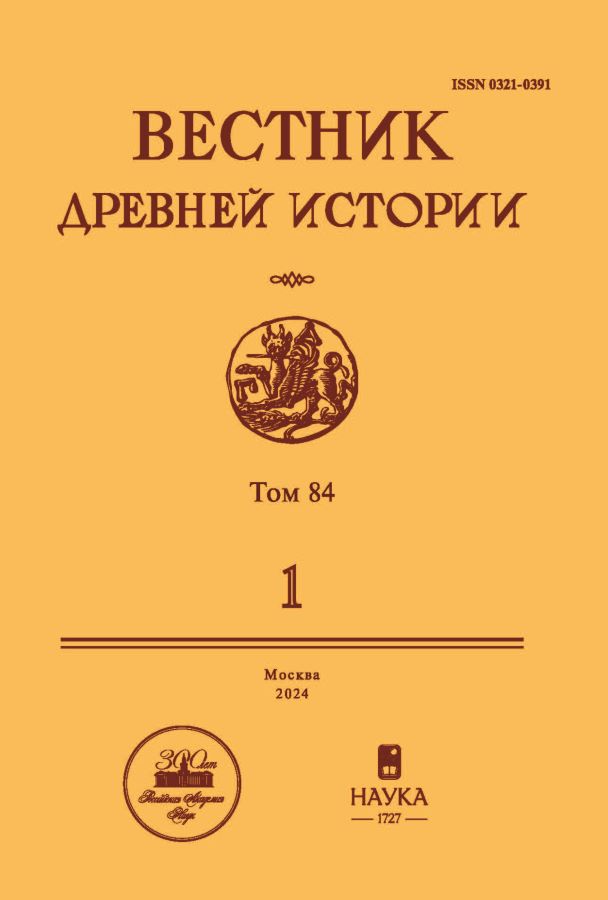Nero’s new Troy: the reception of Virgil and Horace in the Ilias Latina
- 作者: Fratantuono L.1
-
隶属关系:
- Maynooth University
- 期: 卷 84, 编号 1 (2024)
- 页面: 119-130
- 栏目: Articles
- URL: https://rjraap.com/0321-0391/article/view/648633
- DOI: https://doi.org/10.31857/S032103910030334-0
- ID: 648633
如何引用文章
详细
In recent years increased attention had been focused on the miniature epic known as the ‘Latin Iliad’. Close investigation of its relationship to Virgil’s epic ‘Aeneid’ and to the lyric poetry of Horace will illustrate that the author of the Ilias Latina composed a work reflective of the Neronian Age concern with the relationship between Rome and Troy, and with the problem of showing clemency to a defeated enemy. The second of these topics is of particular relevance in light of Seneca and his De Ira and De Clementia.
全文:
作者简介
Lee Fratantuono
Maynooth University
编辑信件的主要联系方式.
Email: Lee.Fratantuono@mu.ie
ORCID iD: 0009-0002-1828-2678
Adjunct Professor at the Department of Ancient Classics
爱尔兰, Maynooth参考
- Aricò, G. 2023: Exitium Troiae funestaque flamma: Il personaggio di Paride nell’Ilias Latina. Philologus 167/1, 83–100.
- Armstrong, R.H. 2008: Classical Translations of the Classics: The Dynamics of Literary Tradition in Retranslating Epic Poetry. In: A. Lianeri, V. Zajko (eds.), Translation and the Classic: Identity as Change in the History of Culture. Oxford, 169–202.
- Austin, R.G. 1971: P. Vergili Maronis Aeneidos liber primus. Oxford.
- Baehrens, E. 1881: Poetae Latini minores. Vol. III. Leipzig.
- Bolton, J.D.P. 1948: Was the Neronia a Freak Festival? Classical Quarterly 42/3–4, 82–90.
- Braund, S.M. 2012: The Anger of Tyrants and the Forgiveness of Kings. In: Ch. L. Griswold, D. Konstan (eds.), Ancient Forgiveness: Classical, Judaic, and Christian. Cambridge, 79–96.
- Braund, S.M., Most, G.W. (eds.) 2003: Ancient Anger: Perspectives from Homer to Galen. (Yale Classical Studies, 32). Cambridge.
- Cairns, F. 2006: Sextus Propertius: The Augustan Elegist. Cambridge.
- Connors, C.M. 1998: Petronius the Poet: Verse and Literary Tradition in the Satyricon. Cambridge.
- Courtney, E. (ed.) 1993: The Fragmentary Latin Poets. Oxford.
- Drinkwater, J.F. 2019: Nero: Emperor and Court. Cambridge.
- Erdmann, M. 2000: Überredende Reden in Vergils Aeneis. Frankfurt am Main.
- Falcone, M.J. 2021: Die Ilias nach Vergil: Zur Charakterisierung trojanischer Helden in der Ilias Latina. In: M. J. Falcone, Chr. Schubert (eds.), Ilias Latina: Text, Interpretation, and Reception. Leiden–Boston, 173–193.
- Falcone, M.J., Schubert, Chr. (eds.) 2021: Ilias Latina: Text, Interpretation, and Reception. Leiden–Boston.
- Fantuzzi, M. 2012: Achilles in Love: Intertextual Studies. Oxford.
- Fletcher, K.F.B. 2006: Vergil’s Italian Diomedes. American Journal of Philology 127/2, 219–259.
- Fratantuono, L. 2018: Tacitus: Annals XVI. London–New York.
- Galasso, L. 2021: Baebius’ Ovid. In: M. J. Falcone, Chr. Schubert (eds.), Ilias Latina: Text, Interpretation, and Reception. Leiden–Boston, 194–210.
- Glei, R.F. 2018: The Ilias Latina as a Roman Continuation of the Iliad. In: R. Simms (ed.), Brill’s Companion to Prequels, Sequels, and Retellings of Classical Epic. Leiden–Boston, 31–51.
- Green, S.J. 2019: How Many Ships Does It Take to Sack Troy? Do the Math with the Ilias Latina. Classical World 112/3, 161–168.
- Griffin, M.T. 1984: Nero: The End of a Dynasty. London.
- Griffin, M.T. 1992: Seneca: A Philosopher in Politics. Revised ed. Oxford.
- Haight, E.H. 1947: The Tale of Troy: An Early Romantic Approach. Classical Journal 42/5, 261–269.
- Heyworth, S.J. 2019: Ovid: Fasti Book III. Cambridge.
- Hilberg, I. 1899: Ist die Ilias Latina von einem Italicus verfasst oder einem Italicus gewidmet? Wiener Studien 21, 264–305.
- Hilberg, I. 1900: Nachtrag zur Abhandlung «Ist die Ilias Latina von einem Italicus verfasst oder einem Italicus gewidmet?». Wiener Studien 22, 317–318.
- Hodapp, W.F. 2019: The Figure of Minerva in Medieval Literature. Woodbridge.
- Horn, F. 2020: The Casualties of the Latin Iliad. Classical Quarterly 70/2, 767–773.
- Kenney, E.J. 1996: Ovid. Heroides, XVI–XXI. (Cambridge Greek and Latin Classics). Cambridge.
- Kilpatrick, R.S. 1992: The Ilias Latina Acrostic: A Milder Remedy. Latomus 51/4, 857–859.
- Levick, B.M. 1983: Nero’s Quinquennium. In: C. Deroux (ed.), Studies in Latin Literature and Roman History. Vol. III. Bruxelles, 211–225.
- Luke, T. 2013: From Crisis to Consensus: Salutary Ideology and the Murder of Agrippina. Illinois Classical Studies 38, 207–228.
- MacDowall, D.M. 1958: The Numismatic Evidence for the Neronia. Classical Quarterly 8/3–4, 192–194.
- McClellan, A.M. 2019: Abused Bodies in Roman Epic. Cambridge.
- Murray, O. 1965: The ‘Quinquennium Neronis’ and the Stoics. Historia: Zeitschrift für Alte Geschichte 14/1, 41–61.
- Nisbet, R.G.M., Rudd, N. 2004: A Commentary on Horace: Odes Book III. Oxford.
- Papaioannou, S. 2000: Vergilian Diomedes Revisited: The Re-Evaluation of the Iliad. Mnemosyne 53/2, 193–217.
- Plessis, F. (ed.) 1885: De Italici Iliade Latina. Paris.
- Putnam, M.C.J. 2018: Baebius Italicus’s Ilias Latina and the End of Vergil’s Aeneid. Vergilius 64, 157–172.
- Reitz, C. 2007: Verkürzen und Erweitern – Literarische Techniken für eilige Leser? Die Ilias Latina als poetische Epitome. Hermes 135/3, 334–351.
- Scaffai, M. (ed.) 1982: Baebii Italici Ilias Latina. Introduzione, edizione critica, traduzione italiana e commento. Bologna.
- Scaffai, M. (ed.) 1997: Baebii Italici Ilias Latina. Introduzione, edizione critica, traduzione italiana e commento. 2nd ed. Bologna.
- Schubert, Chr. 1999: Ein Zeugnis aus Neros Dichterkreis? Zu den Kryptogrammen der Ilias Latina. Würzburger Jahrbücher für die Altertumswissenschaft 23, 137–141.
- Shackleton Bailey, D.R. (ed.) 1985: Quintus Horatius Flaccus. Opera. (Bibliotheca scriptorum Graecorum et Romanorum Teubneriana). Stuttgart.
- Spence, S. 1999: The Polyvalence of Pallas in the Aeneid. Arethusa 32/2, 149–163.
- Thornton, M.K., Thornton R. L. 2008: Julio-Claudian Building Programs: A Quantitative Study in Political Management. Wauconda (IL).
- Traina, A. 1988: Pietas. In: F. Della Corte (ed.), Enciclopedia virgiliana. Vol. IV. Roma, 93–101.
- Traina, A. (ed.) 2017: Virgilio: l’utopia e la storia: Il libro XII dell’Eneide e antologia dell’opere. Bologna.
- Woodman, A.J. 2022: Horace. Odes, Book III. Cambridge.
- Woods, M.C. 2019: Weeping for Dido: The Classics in the Medieval Classroom. Princeton.
- Ziegler, J. 2012: Die Gestalt des Achilles in den lateinischen nachklassichen Trojadarstellungen der Antike (Ilias Latina, Dictys Cretensis, Dares Phrygius, Excidium Troiae). Diplomarbeit. Wien.
补充文件









